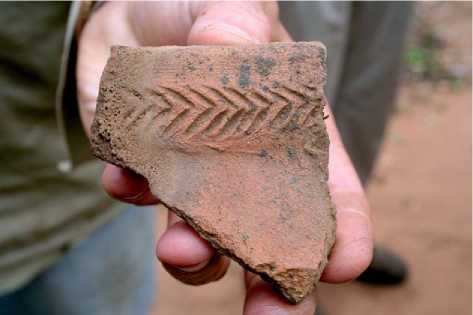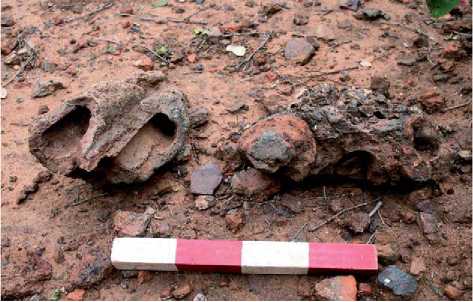Settled farmers identified with the speakers of ancestral Bantu languages were established in much of southern Africa, including the Zimbabwe plateau by the early first millennium CE. Their origins lie somewhere in the northern Equatorial rain forests. It remains unclear how they spread over much of the region in a fairly short period of time. The process may have involved ‘slash-and-burn’ agriculture whereby after few years, communities would abandon a piece of land due to marginal fertility of the soils, and move on to another. This process is dated from the third century BCE and continues throughout the first and early second millennium CE, attesting

Figure 3 Example of pottery made by agro-pastoralist farmers between cal CE 400 and 600. This Happy Rest potsherd was recovered from an extensive village site on the margins of the plateau in the Tswapong Hills of Botswana. Photo: P Fredrikson.
To the expansion and spread of farming activities and iron production in southern Africa.
Archaeological sites yielding well-fired, thickbodied ceramics decorated with either grooved or comb-stamped designs identify the expansion and spread of agro-pastoral societies (Figure 3). Most sites exhibit metalworking, the keeping of livestock, and pole-and-daub structures of permanent settlement. This pottery has been recovered from the Lake Victoria interior and coastal regions of eastern Africa, much of central Africa, the northern highveld and the eastern coastal zones of South Africa. This pottery is identical in both structure and design. Archaeologists have ascribed it to traditions or cultures which are further divided into time segments (phases), and geographical areas (facies). On the Zimbabwe plateau, such traditions include Gokomere-Ziwa, Zhizo, Kadzi, and Chinhoyi and they are all associated with early farming and iron-using communities who grew Bambara groundnuts, cucurbits, sorghum, and cow peas. They supplemented these with wild grasses and plant foods, wild animals, and marine resources. Cattle were very important in the sociopolitical and economic organization of these societies. This significance was expressed through a binary-coded settlement system known as the Central Cattle Pattern. Residential units surrounded cattle byres, which were the domain of men. Archaeologists unveiled this settlement pattern at Tabazingwe in western Zimbabwe, Kgaswe on the margins of the Kalahari and Schroda in northern South Africa (see Plant Domestication).
From CE 600, these early farmers established large village settlements in the plateau and adjacent areas. Mainly situated along fertile agricultural soils and river basins, village sites covered areas averaging at least 5 ha in extent. Archaeological evidence from sites such as Kadzi and Swart Village in northern Zimbabwe, Schroda in the Limpopo Valley, and various sites in the Tswapong Hills of Botswana attest to these villages as hubs of religious, economic, and political activities. Craft specialization was well developed as shown by the ubiquity of concentrated remains of iron - (Figure 4) and ivory-working. This was strongly interwoven with the development of intraregional trade and the integration of the Zimbabwe plateau area into the world system through the Indian Ocean long-distance trade that connected the interior

Figure 4 Multiple fused tuyeres from a possible specialist iron smelting village, Tswapong Hills, Botswana.
Of southern Africa with parts of Asia and the Persian Gulf. In this long-distance trade network, local products including ivory and iron were exchanged for exotic goods such as glass beads.




 World History
World History









